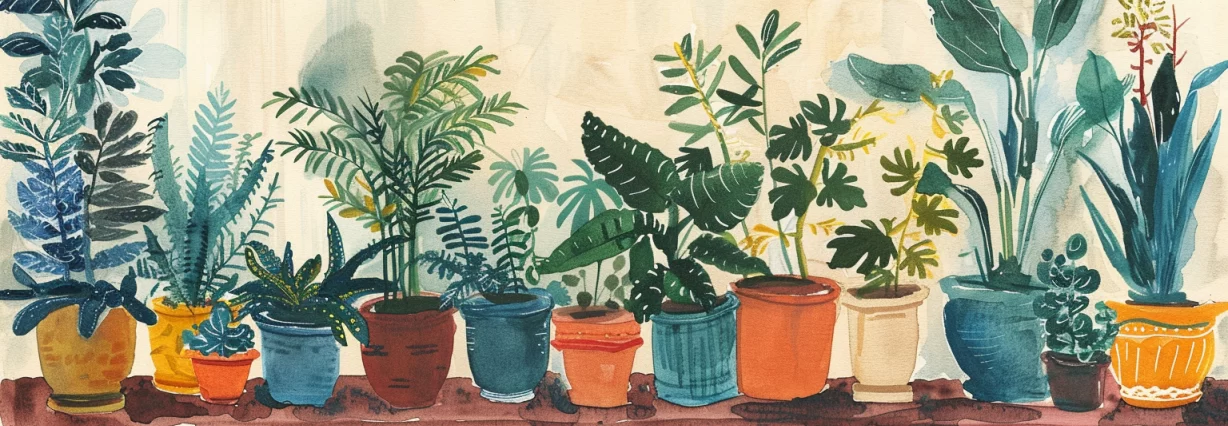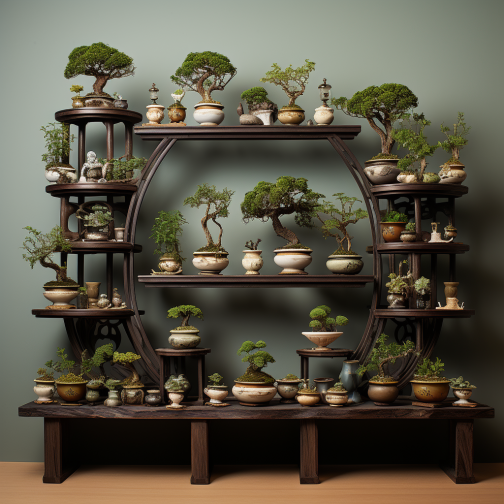Bonsai trees are a unique and beautiful addition to any home or garden. These miniature trees require careful attention and maintenance to thrive, and part of that maintenance includes choosing the right pots and stands for display. Bonsai display is an art form that involves showcasing the tree in a way that emphasizes its aesthetic qualities and creates harmony between the tree, the pot, and the stand.

When it comes to choosing the right pot for a bonsai tree, there are several factors to consider. The size and shape of the pot should be proportional to the size and shape of the tree, and the color and design of the pot should complement the tree’s foliage and bark. The pot should also be deep enough to accommodate the tree’s roots and allow for proper drainage. When selecting a pot, it is important to keep in mind that the pot is not just a container for the tree, but an integral part of the overall aesthetic of the display.
In addition to the pot, the stand is another important element in bonsai display. The stand serves to elevate the tree off the ground, providing better visibility and stability. Like the pot, the stand should be chosen to complement the tree and pot, creating a harmonious display. The stand should also be sturdy enough to support the weight of the tree and pot and should be of an appropriate height to ensure the tree is displayed at its best angle. Choosing the right pots and stands for bonsai display is an important part of creating a beautiful and harmonious display.
Understanding Bonsai Display Essentials
The Art and Philosophy of Bonsai Display
Bonsai is more than just a hobby or a plant-growing technique. It is an art form that originated in Japan and has been practiced for centuries. The art of bonsai involves cultivating small trees or shrubs in carefully shaped and pruned containers to create a miniature representation of nature. Bonsai is a reflection of nature and a way to connect with it.
Bonsai display is an essential aspect of the art form. It is the process of showcasing the bonsai tree in a way that highlights its natural beauty and captures the essence of nature. The display of bonsai is not just about placing the tree in a container. It is about creating an aesthetically pleasing, balanced, and harmonious composition.
Key Elements of Display Composition
Bonsai display composition is a delicate balance of art and nature. The composition should be designed to convey a sense of harmony and balance while also drawing attention to the unique features of the bonsai tree. Here are some key elements to consider when creating a bonsai display:
- Container: The container is an essential element in bonsai display. It should be chosen carefully to match the style and size of the tree. Traditional Japanese containers are often used, but modern containers can also be used to create a unique look.
- Stand: The stand elevates the bonsai tree and gives it more prominence. The stand should be chosen to match the style and size of the tree and container. It should also be sturdy and able to support the tree’s weight.
- Accent Plants: Accent plants are used to complement the bonsai tree and add to the overall composition. They should be chosen carefully to match the style and size of the tree and container. They should also be placed in a way that enhances the overall composition.
- Attention to Detail: Attention to detail is essential in bonsai display. Every element of the composition should be carefully considered, from the placement of the tree to the choice of accent plants. The goal is to create a composition that is aesthetically pleasing and balanced.
Bonsai display is a traditional art form that has cultural significance in Japan and around the world. It requires attention to detail, a sense of aesthetics, and a deep appreciation for nature. By understanding the key elements of bonsai display composition, you can create a beautiful and harmonious display that showcases the natural beauty of the bonsai tree.
Selecting the Perfect Pot
Choosing the right pot is a crucial step in the art of bonsai. The pot should complement the tree’s style and enhance its overall appearance. The following subsections will provide guidelines for selecting the perfect pot for your bonsai.
Size and Proportion
The size of the pot should be proportional to the size of the tree. A pot that is too large or too small can affect the tree’s health and growth. The pot’s depth should be approximately the same as the tree’s root ball, measured just above the flare. The width of the pot should be slightly wider than the tree’s branches to provide stability.
Color and Texture
The color and texture of the pot should complement the tree’s appearance. Neutral colors like brown, beige, and gray are popular choices as they do not detract from the tree’s beauty. Textured pots can add interest and depth to the display.
Material Considerations
The material of the pot can affect the tree’s growth and appearance. Ceramic and clay pots are popular choices as they are durable and provide good insulation. They also come in a variety of colors and textures. Plastic and metal pots are also available but may not provide the same insulation as ceramic or clay pots.
Drainage and Functionality
Proper drainage is essential for the health of the tree. The pot should have drainage holes to allow excess water to escape. The pot should also have a tray to catch any water that drains out. The pot’s shape should also be considered. Round and oval pots are common choices but rectangular and square pots can also be used to create a more modern look.
In conclusion, selecting the perfect pot for your bonsai is an important decision that should not be taken lightly. The pot’s size, color, material, and functionality should all be considered to ensure the tree’s health and appearance.
Choosing the Right Stand

When it comes to displaying a bonsai tree, choosing the right stand is just as important as selecting the right pot. The stand elevates the tree to eye level and complements its beauty. This section will look at the different types and styles of bonsai stands, the materials used, and the factors to consider when choosing the right stand.
Stand Types and Styles
There are various types and styles of bonsai stands to choose from, including dai, jita, and bonsai display stands. A dai is a traditional Japanese bonsai stand that is usually made of wood and has a flat surface. The jita, on the other hand, is a more modern stand that is often made of metal or bamboo and has a more contemporary design. Bonsai display stands come in different shapes and sizes and can be used to showcase multiple bonsai trees.
Material and Durability
The material used to make the stand is essential when choosing the right stand for your bonsai tree. Wood is a popular choice for bonsai stands because it is durable and complements the tree’s natural beauty. Bamboo is another option that is lightweight and eco-friendly. Metal stands are also available, and they are known for their durability and stability.
Height and Stability
The height and stability of the stand are other important factors to consider. The height of the stand should be proportional to the size of the tree and the pot. A taller stand can make the tree look more majestic, while a shorter stand can make it look more grounded. The stand should also be stable enough to support the tree’s weight and withstand any wind or movement.
In summary, choosing the right stand for your bonsai tree is crucial for displaying its beauty and maintaining its health. The stand’s style, material, height, and stability are all factors to consider when making your selection. By considering these factors, you can find the perfect stand that complements your bonsai tree’s natural beauty and enhances its display.
Designing Your Bonsai Display

When it comes to designing a bonsai display, there are several factors to consider. Every element plays a crucial role in achieving a harmonious and visually appealing display, from the composition to the display stands.
Creating Visual Interest
One of the key aspects of designing a bonsai display is creating visual interest. This can be achieved by incorporating elements such as contrasting colors, textures, and shapes. For example, pairing a bonsai tree with a display stand that has a different texture or color can create a striking contrast that draws the eye.
Balancing Elements
Another important consideration when designing a bonsai display is achieving balance. A well-balanced display will have a focal point that draws the eye but also incorporates other elements that complement and support it. This can be achieved by using display stands of varying heights or incorporating accent pieces such as rocks or figurines.
Positioning and Placement
Finally, the positioning and placement of the bonsai tree and display stands are crucial to achieving a minimalist and harmonious display. The bonsai tree should be positioned in a way that allows it to be viewed from all angles while also being placed at a height that is comfortable for the viewer. Display stands should be placed to support the overall composition without overpowering the bonsai tree.
Overall, designing a bonsai display requires careful consideration of each element, from the composition to the display stands. By creating visual interest, achieving balance, and carefully positioning and placing each element, it is possible to create a visually stunning display showcasing the bonsai tree’s beauty.
Caring for Your Bonsai and Display

Maintenance and Pruning
Maintaining your bonsai tree is crucial to its health and longevity. Regular pruning helps maintain the tree’s shape and size while promoting new growth. It is recommended to prune your bonsai tree at least once a year, preferably in the spring or early summer. During pruning, removing any dead, diseased, or damaged branches is important to prevent the spread of infection.
Watering and Nutrient Management
Watering your bonsai tree is an essential part of its care. Overwatering or underwatering can cause serious damage to the tree. It is important to water your bonsai tree only when the soil is dry to the touch. The frequency of watering depends on the tree species, the pot size, and the climate. Nutrient management is also crucial for the health of your bonsai tree. Fertilize your tree with a balanced fertilizer every two to four weeks during the growing season, and reduce or stop fertilization during the dormant season.
Seasonal Adjustments
Seasonal adjustments are necessary to ensure the health of your bonsai tree. During the winter, it is important to protect your tree from freezing temperatures by bringing it indoors or providing a protective cover. In the summer, providing shade for your tree is important to prevent it from overheating. Additionally, adjusting the amount of water and fertilizer during the different seasons is essential for the health and growth of your bonsai tree.
Maintaining the health of your bonsai tree is essential for a successful display. By following these care tips, you can ensure that your bonsai tree remains healthy and green for years to come.
Accessorizing Your Display

Once you have chosen the perfect pot and stand for your bonsai tree, it’s time to accessorize your display. Adding accent plants and figurines, using moss and stones, and incorporating backdrops can enhance the aesthetic details of your display and add character and story to your bonsai tree.
Accent Plants and Figurines
Accent plants and figurines can complement your bonsai tree and add natural beauty to your display. Choose plants that have a similar growth habit to your bonsai tree and place them in a small pot next to your bonsai. Figurines can also be used to add character and story to your display. Choose figurines appropriate for your bonsai tree’s size and style.
Using Moss and Stones
Moss and stones can be used to create a natural-looking base for your bonsai tree. Moss can be used to cover the soil surface of your bonsai pot, while stones can be used to create a pathway or to create a natural-looking landscape. Choose moss and stones that complement the color and style of your bonsai tree.
Incorporating Backdrops
Backdrops can be used to create a simple and elegant display for your bonsai tree. A plain white or black backdrop can be used to highlight the natural beauty of your bonsai tree. Alternatively, you can use a backdrop that complements the color and style of your bonsai tree. A garden or outdoor setting can also be used as a backdrop for your bonsai tree display.
Incorporating these simple accessories can enhance the natural beauty of your bonsai tree and create a simple and elegant display. Keep in mind that simplicity is key when accessorizing your bonsai tree display.
Display Variations and Inspirations

When it comes to displaying bonsai trees, there are endless variations and inspirations to choose from. Here are some of the most popular display themes and ideas to help you get started.
Indoor vs. Outdoor Displays
Indoor bonsai displays are perfect for those who want to showcase their trees in a controlled environment. They allow you to create a mini garden that can be enjoyed year-round, regardless of the weather outside. On the other hand, outdoor displays are ideal for creating a natural and organic look. They allow you to incorporate your bonsai trees into your garden or landscape, creating a seamless transition between your trees and the surrounding environment.
Modern vs. Traditional Themes
Regarding bonsai display themes, there are two main categories: modern and traditional. Traditional displays focus on creating a natural look that mimics the tree’s natural habitat. They often incorporate traditional Japanese elements like stones, sand, and water. On the other hand, modern displays are more abstract and focus on creating a unique and contemporary look. They often incorporate unconventional elements, such as metal or glass.
DIY and Custom Display Ideas
DIY and custom display ideas are a great option for those who want to create a truly unique display. These ideas allow you to incorporate your personal style and creativity into your display. Some popular DIY ideas include creating your own display stands or using unconventional containers, such as teapots or wine bottles. Custom display ideas can include incorporating family heirlooms or other sentimental items into your display.
Overall, the key to creating a beautiful bonsai display is finding inspiration and incorporating elements that speak to your style. Whether you prefer a traditional or modern look, indoor or outdoor displays, or DIY or custom ideas, there are endless possibilities to choose from.
Conclusion

In conclusion, choosing the right pots and stands for bonsai trees is crucial to enhancing the overall appearance and elegance of the bonsai art. It requires patience and careful consideration of the context in which the bonsai tree will be displayed. The cultural significance of bonsai art should also be taken into account when selecting the appropriate pots and stands.
When it comes to selecting pots, drainage is a key factor to consider. Proper drainage ensures that the roots of the bonsai tree do not rot, promoting healthy growth. The pot’s material should also be considered, with options including ceramic, porcelain, and plastic.
Stands are equally important, as they elevate the bonsai tree and provide a focal point for the eye. The type of stand chosen should complement the style of the bonsai tree, with options including wooden, metal, and stone stands.
Different species of bonsai trees may require different pots and stands. For example, juniper trees may benefit from a shallow pot, while maple trees may require a deeper pot. Pine trees, on the other hand, may require a wider pot to accommodate their roots. Cedar trees, which are known for their durability, may benefit from a sturdy stand made of stone or metal.
Overall, selecting the right pots and stands for bonsai trees requires knowledge and a keen eye for detail. By taking the time to carefully select the appropriate pots and stands, the beauty and peace of bonsai art can be fully appreciated.


